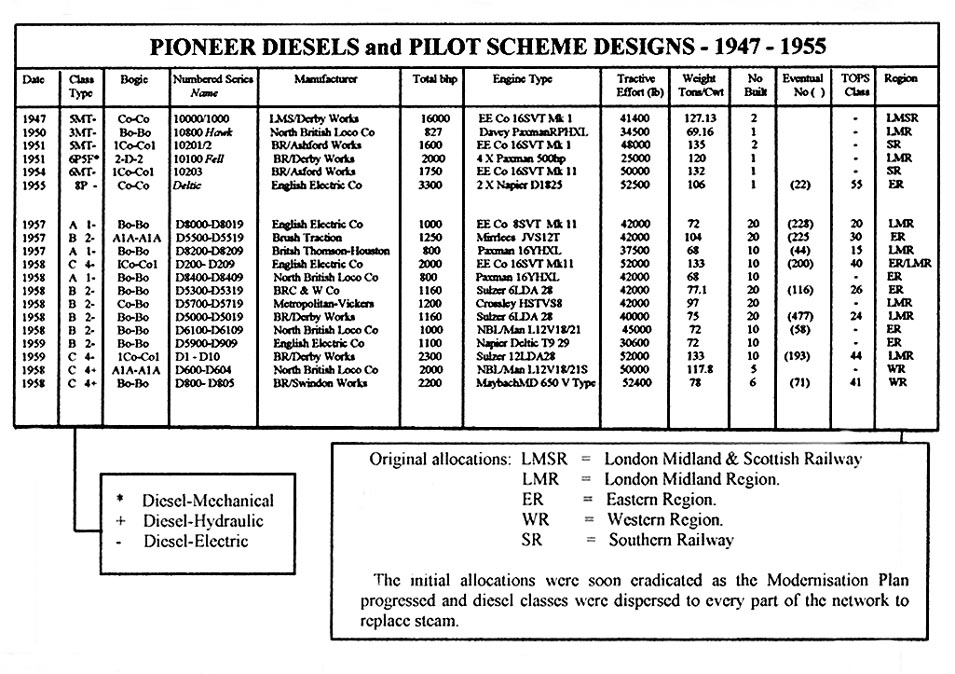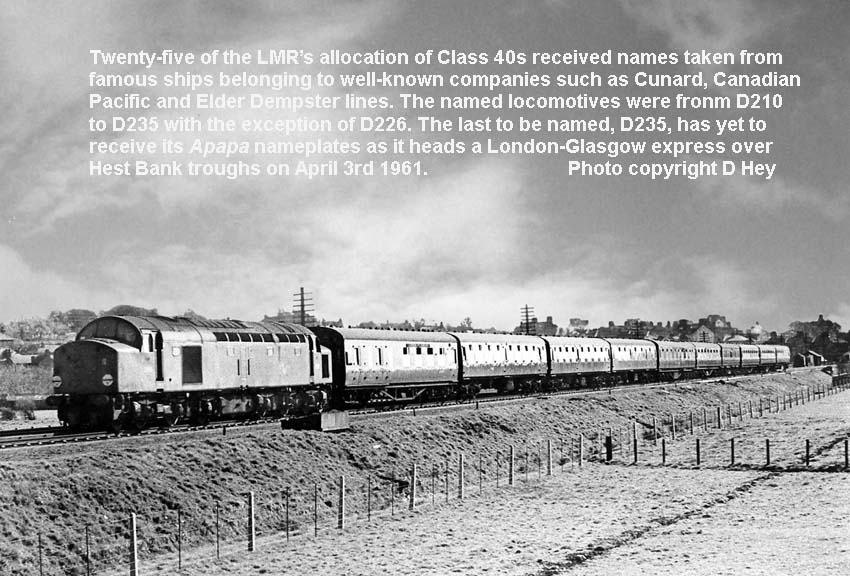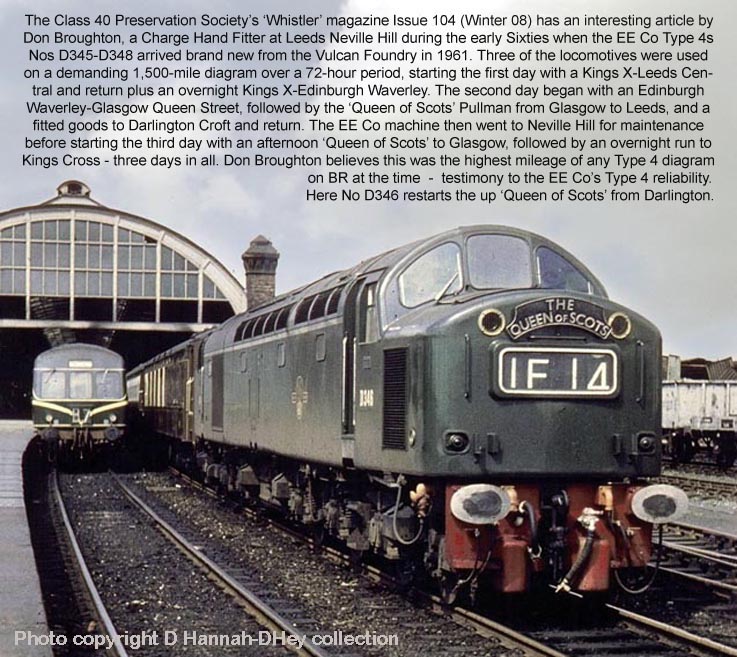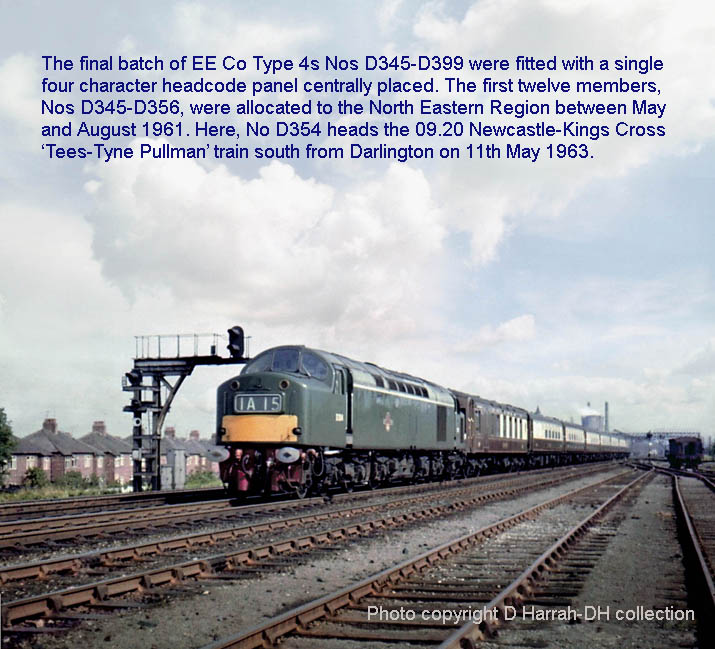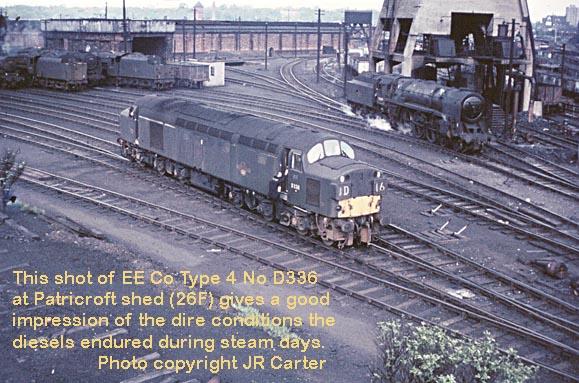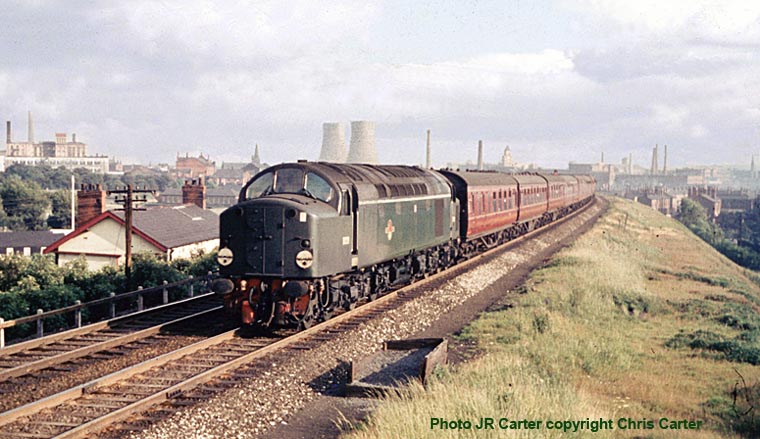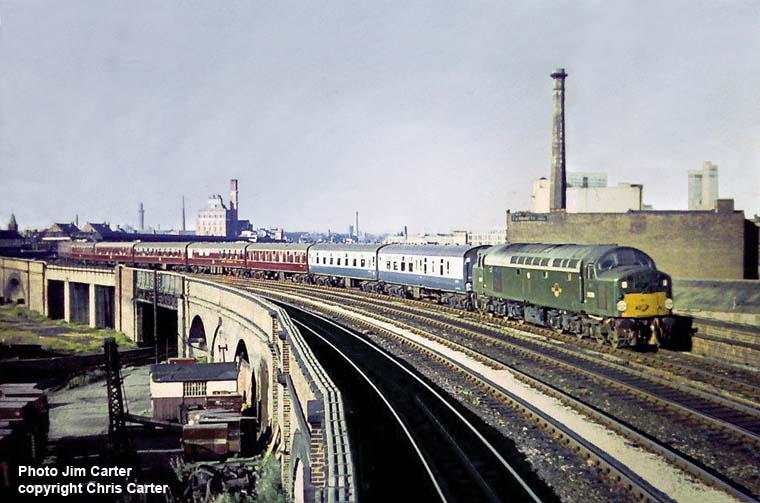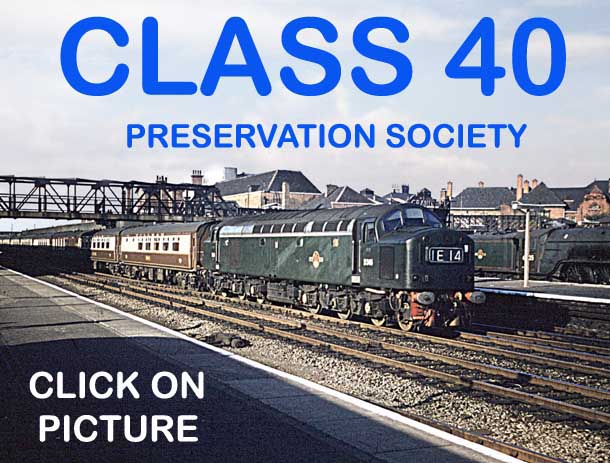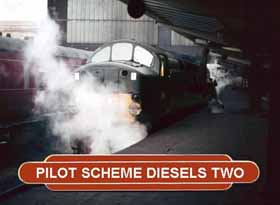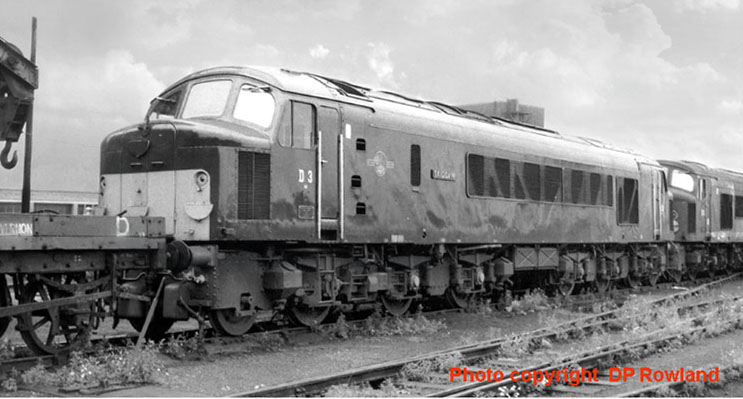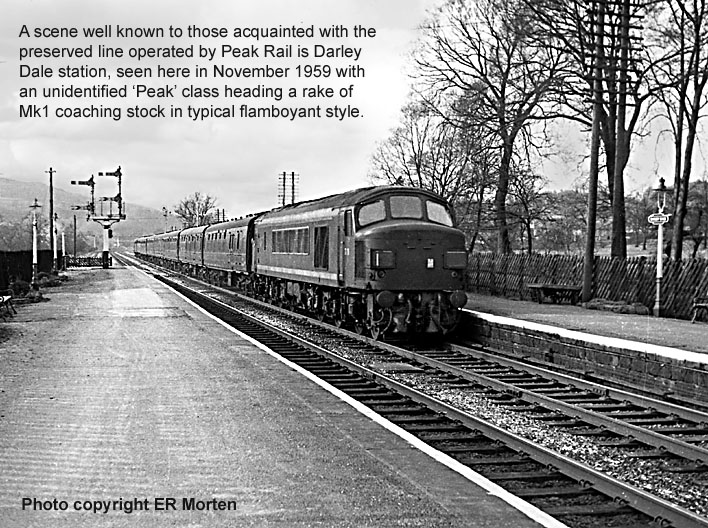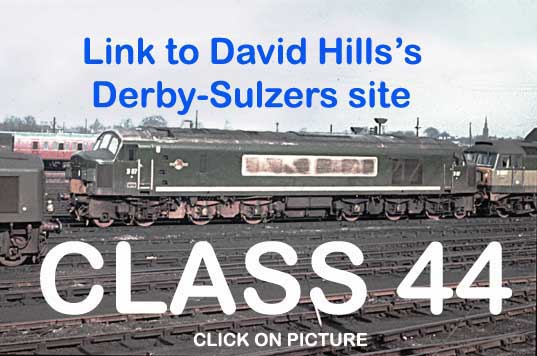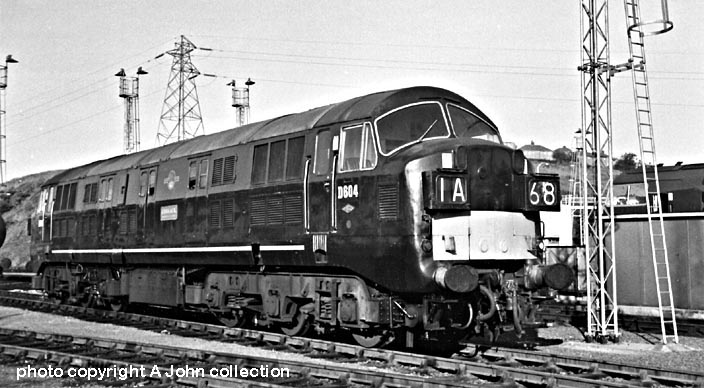The headlong rush to get rid of steam meant that BR's heterogeneous collection of new diesels was acquired by a completely irrational process and, without the benefit of full prototype trials, several early types were quickly eliminated from BR stock. However, the poor performance of the early diesels was not always the fault of the pilot scheme manufacturers, rather the dire conditions in which they were kept. The new diesels had to share facilities at dirty steam depots, and because BR's staff was still embroiled in old-fashioned steam techniques (therefore having little experience of diesel traction) all too often a diesel locomotive was immobolised because drivers were unfamiliar with the complicated circuitry attributed to the different types introduced in the pilot scheme. This went some way to tarnishing the reputation of the manufacturers, when much of the blame for unreliability lay at the door of British Railways for rushing into dieselisation too fast. By 1960, rail fans had abandoned all hope of a reprieve for steam. The new diesels were taking over the asylum, yet it was as plain as day that modernisation was all over the place. By 1961, BR's finances had dipped deeper into the red to a whopping £87.2 million deficit, which was a major embarrassment in Whitehall circles - and, judging by the high number of diesel breakdowns that occurred, it was clear that a full reassessment of the entire question of diesel maintenance was needed, particularly in the training of a workforce to a new, and often, unwelcome way of thinking.
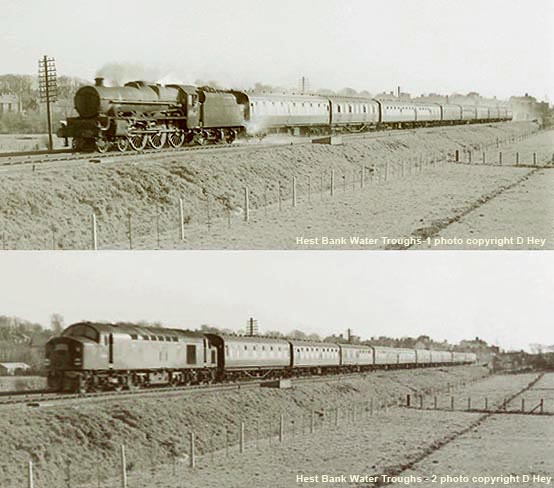

(Above-Below) Incompatible bedfellows! 'Peak' class No D77 Royal Irish Fusilier and an unidentified 'Black Five' stand side-by-side in the shed yard at Holbeck in March 1965. For the record, 1965 saw the number of main line diesels increase by 353 to 2,811, whereas BR's fleet of steam locomotives was reduced by 1,986 to 2,987. In that same year, 92% of the total coach train miles was operated by diesel and electric traction as against 87% in 1964. Photo: B Lister (Below) Reference guide to nine pioneer diesel prototypes and pilot-scheme diesels introduced on British Railways between 1947 and 1955. Click on graph to enlarge image.
The first problem to be addressed was the prevalence of steam-heat only coaching stock inherited from the former 'Big Four' railway companies. It would take several years before BR's passenger stock became fully equipped with electrical train heating (ETH) therefore bulky steam heating boilers had to be installed on the Type 2 and Type 4 mixed traffic locomotives, which not only increased the locomotive's weight (thereby restricting their route availability) the steam heat equipment was prone to failures during the winter months and this precluded their use on passenger duties when they were most needed. Inadequate braking power was another problem, particularly on heavy loose-coupled freights, therefore the BTC ordered a fleet of diesel brake tenders which were coupled to diesel locomotives for use on non-fitted and partially fitted goods trains. The tenders were built of low-profile so as not to obstruct the driver's vision and mounted on old Gresley carriage bogies, making a deadweight load equivalent to six brake wagons. The tenders were used extensively throughout the network pending the arrival of fully fitted freight workings.
EE Co TYPE 4 (CLASS 40)
The English Electric Co Type 4 (Class 40) The first ten pilot-scheme Type 4s were a direct development of the SR trio Nos 10201-3, which were produced in collaboration with the EE Co between 1951-54. However, the BR locos more closely resembled that of the last Bulleid machine, No 10203, powered by the same 16SVT engine uprated to 2,000hp. Due to the weight of the bulky power equipment, however, the Type 4 was fitted with the rather cumbersome 1Co-Co1 bogie design made up of three motored wheels and an outer non-motored guiding axle to distribute its weight and reduce track wear. The success of the ten EE Co Type 4s led to a production run of 190 locomotives, Nos D210-D399, all painted in BR Brunswick green livery, with a grey roof and a light grey shoulder band below the roof-mounted filter louvres. The earliest examples were also fitted with nose-front ladders to allow maintenance staff access to two hinged hatches on top of the nose, but these were discontinued for safety reasons when working in areas with overhead electrification equipment.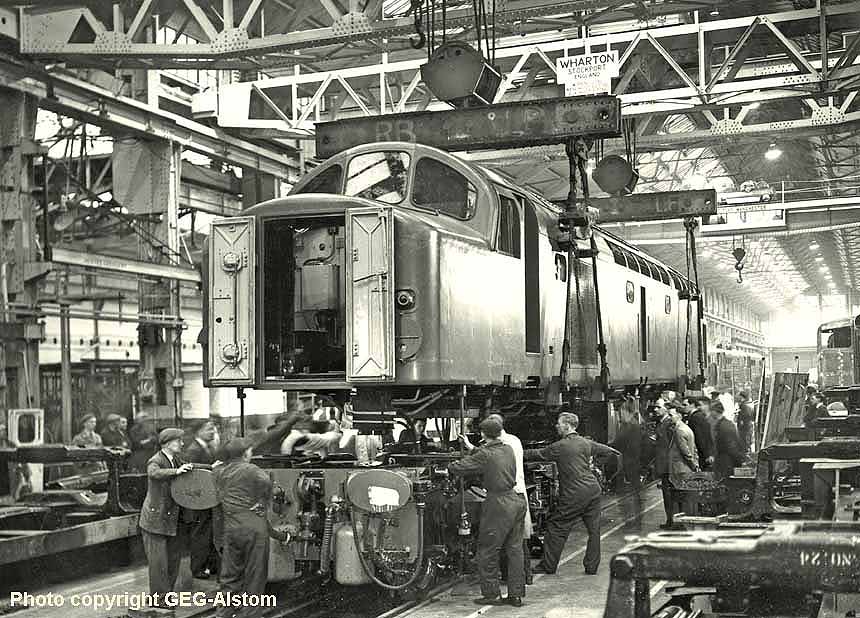
(Above-Below) The body of D200 is guided onto its underframes at the Vulcan Foundry in February 1958. Note the buffers and associated drawgear attached to the bogie frame, which was logical enough given the concomitant body overhang when the bogie pivots outwards. A gangway door was incorporated in the nose end to allow train crews access between locomotives when operating in multiple. Enginemen used doors like these on the underpowered LMS and SR prototypes, but rarely on the EE Co machines and they were subsequently dropped from D325 onwards in May 1961. (Below) The finished product in works primer, awaiting its BR standard green livery, with a light grey shoulder band along the bodyside below the roof-mounted filter lovres. The BTC's specification for headcode disc displays to be incorporated on the nose end was used on Nos D200-324. The four discs could be used in various combinations to indicate the type of train being worked. These gave way to fo ur-character headcode boxes on either side of the nose on D325-D344, and a centrally positioned headcode panel on D345-D399. Both © GEC-Alstom
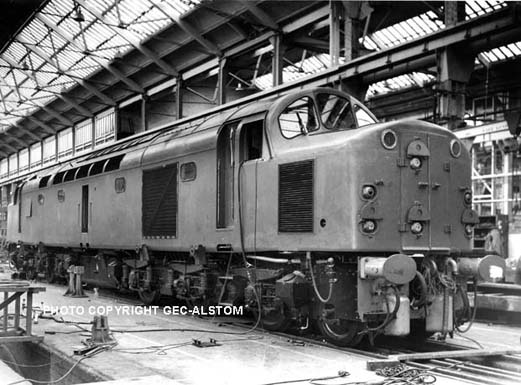
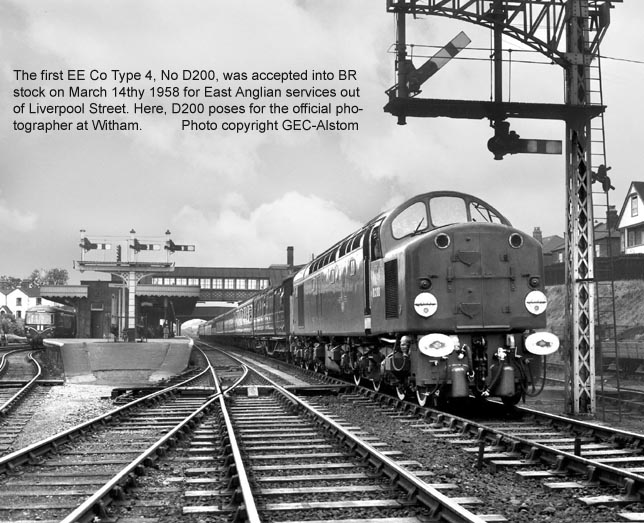
(Above-Below) The first EE Co Type 4, No D200, was accepted into BR stock on March 14th 1958 for East Anglian services out of Liverpool Street. The Eastern Region took delivery of all the ten pilot scheme EE Co Type 4s, with Nos D200, D202-5 going to Stratford, and Nos D201, D206-9 to Hornsey (later Finsbury Park) for the GN line out of Kings Cross. During the 1960s a new terminology 'Drivers Safety Device' was introduced to replace 'Deadmans Handle'. It was hoped that by dropping the original term it would remove any suggestion that it was a safeguard against drivers dropping dead at the controls! No D200 poses at Witham in 1958. 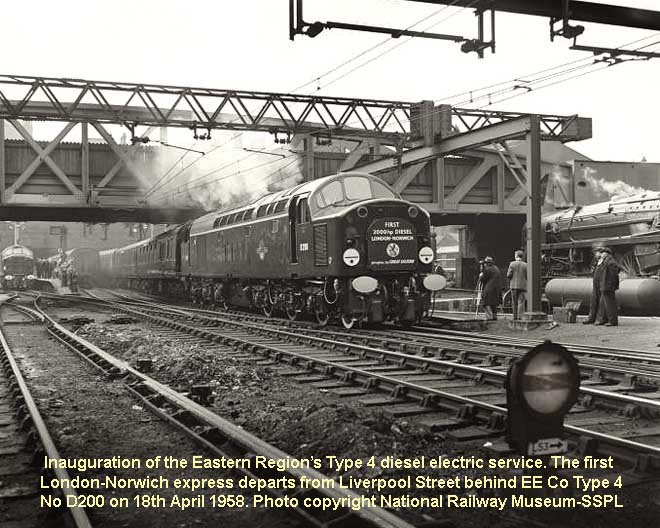
(Below) The 'Master Cutler' has a varied history. The titled train was innaugurated on the London & North Eastern Railway from Sheffield Victoria to Marylebone via the Great Central route in 1947. Following the closure of the GC line, the 'Master Cutler' Pullman was diverted to run on the East Coast Main Line via Retford into Kings Cross. This rarely seen publicity shot shows an unidentified machine awaiting departure with the 'up' train at Sheffield Victoria...the boys donning school caps and satchels are a sign of the times!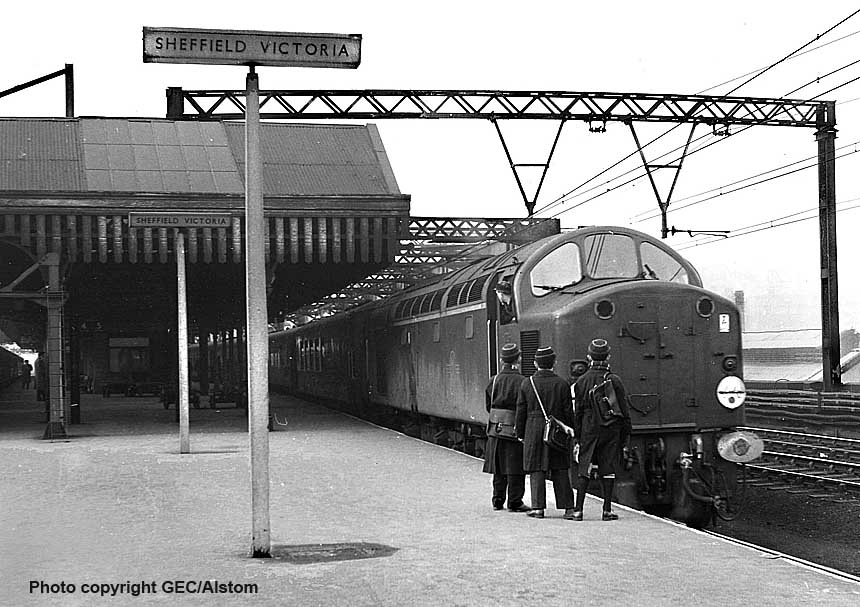

(Above-Below) After purchasing a 35mm slide-negative scanner this long-forgotten old photo was unearthed showing an unidentified EE Co Type 4 heading the northbound 'Queen of Scots' up the bank to Horsforth on the Leeds-Harrogate line in 1960. (Below) The 'Master Cutler' Pullman was often used as a test train for new locomotive designs, notably DP2, Lion, Kestrel and Falcon prototypes. (Below) When the EE Co pilot scheme Type 4s D201/D206-9 arrived at Hornsey (later Finsbury Park) the Eastern Region revived the Pullman service between Kings Cross and Sheffield Victoria. The lightweight 'Master Cutler', usually made up of six Pullman cars of 250 tons gross tons, ran twice each day with stops at Peterborough, Grantham and Retford. Here, No D208 heads the down 'Master Cutler' across Retford North Junction on the curve to Whisker Hill Junction to gain the Sheffield lines in April 1959.
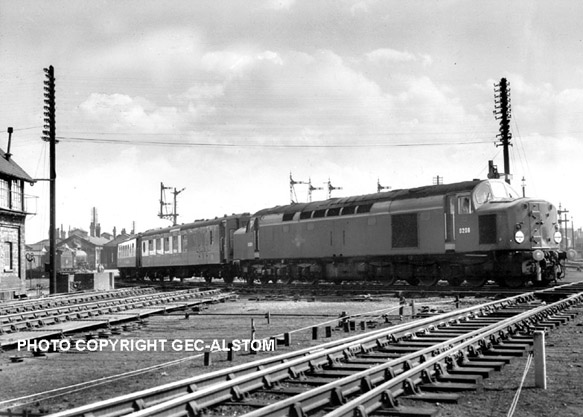
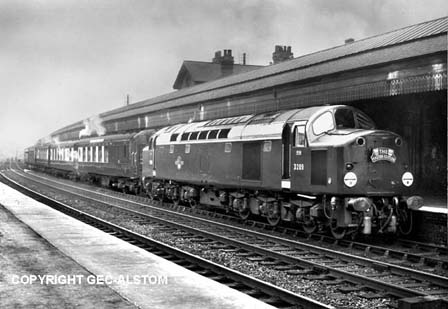
(Above-Below) No D209 pauses at Retford with the 'up' Pullman in September 1959. A typical diagram for the Hornsey machines was the down 'Master Cutler out of Kings Cross and the next mornings 07.20 return from Sheffied Victoria, spending their time in the Yorkshire area with overnight freight workings to and from Annesly yard, Nottingham. Photo © GEC/Alstom (Below) With increased demands for economies in rail operation, greater emphasis was given to the introduction of more efficient loco rosters, though it was disappointing that the early diesels were unable to offer the complete predictability that was expected. Given reasonable maintenance, a diesel locomotive's performance should be more accurately predicted than steam, whereas that of an individual driver was not. However, this was not entirely the fault of the driver. At the time, the renewal of ECML trackwork and signalling was long overdue and BR's timetable was made up of a depressing compilation of engineering slacks. Lavish recovery margins were incorporated into the timetable to allow train crews the chance to regain lost time, but contrary to their purpose the margins discouraged crews of any initiative to recover the time lost, and until outdated semaphore signalling was replaced by modern multiple aspect signalling (MAS) the possibility of constant high-speed running by the EE Co Type 4s could not be fully exploited. It was several years before the ECML was modified for 100mph running between Kings Cross and Newcastle, by which time the more powerful EE Co Type 5 Deltics had taken the helm. Aged semaphores are much in evidence as EE Co Type 4 D206 passes Barkston South Junction with an 'up' express on 16 August 1958. Photo © PR Batty
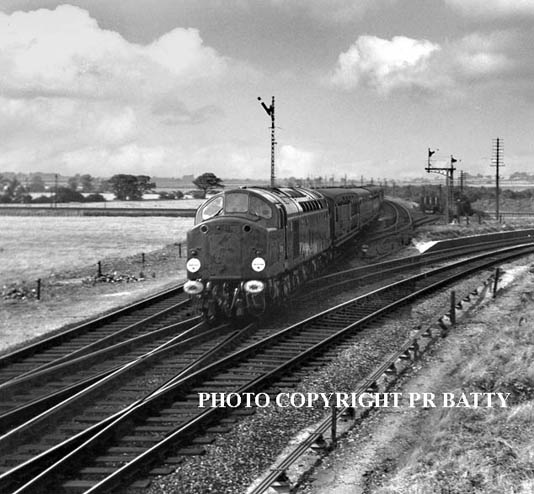
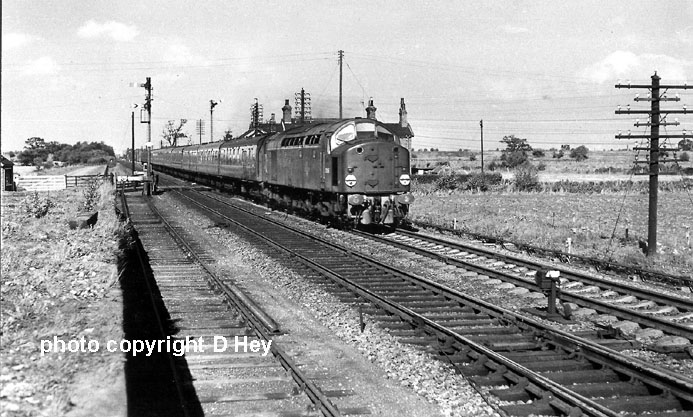
(Above) Despite several flaws that manifested itself during early service, the EE Co Type 4 eventually became established as the standard locomotive for ECML express working. No D256 is seen heading a down express through Temple Hirst station on the now-closed section of ECML south of Selby.
(Below) The first production EE Co Type 4s destined for the LMR were delivered between May and November 1959. They were allocated initially to Camden, Wiilesden, Crewe and Carlisle Upperby, then to Edge Hill and Longsight as deliveries proceeded. The LMR's first twenty five EE Co Type 4s, Nos D210-D235 (with the exception of D226) received names taken from famous ships belonging to the Canadian Pacific, Cunard and Elder Dempster Lines - all three companies being associated with sailings from the port of Liverpool. A named locomotive certainly added some much-needed panache to the early days of dieselisation. The EE Co's Type 4 No D211 - the second of the LMR's Camden batch, introduced to traffic in June 1959 - was named Mauretania by the Chairman of the Cunard Steamship Company at Liverpool Riverside in September 1960. Bearing the distinctive tartan-coloured 'Royal Scot' headboard, No D211 skims over Hest Bank troughs with the 'down' express on April 3rd 1961 Photo © D Hey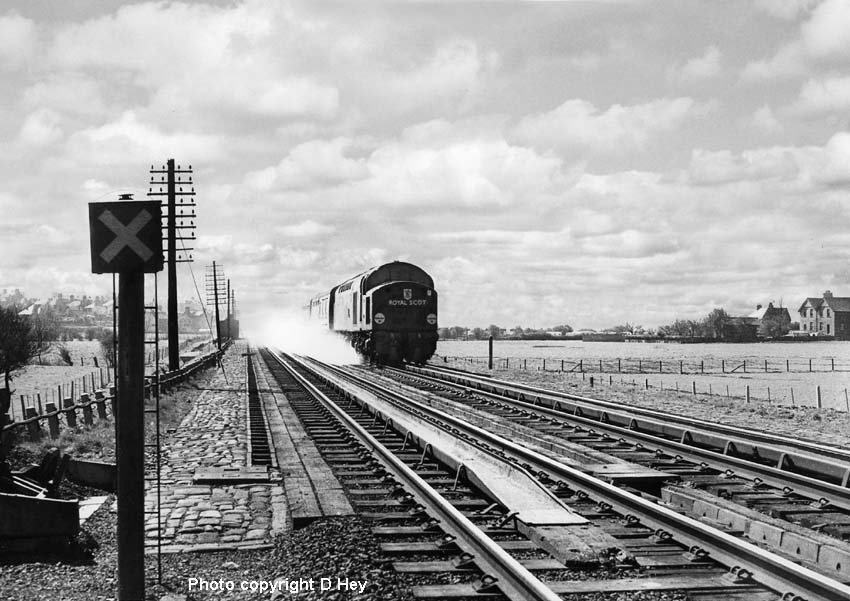
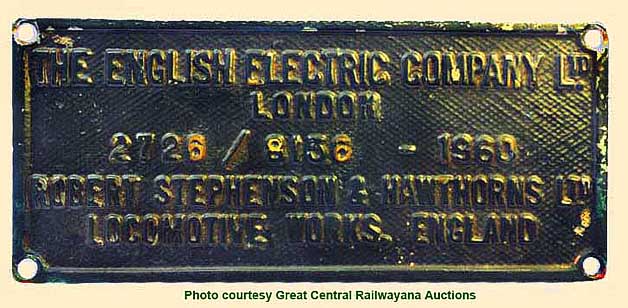
(Above-Below) Class 40 survivor! Following the success of the EE Co's pilot scheme Type 4s D200-D209, a further 190 locomotives D210-D399 were ordered, all built at Vulcan Foundry except for a batch of twenty Nos D305-D324 built at the Robert Stephenson and Hawthorns works in Darlington. This is the locomotive works plate from the second loco in the batch, No D306. It shows the name of the English Electric Company Ltd London - 1960 Robert Stephenson & Hawthorns Ltd. Locomotive Works, England. The chromed brass works plate measuring 10" x 4½" went under the hammer for £500 at a Great Central Railwayana Auction in January 2011. No D306 entered traffic in October 1960 based atCrewe North shed (5A). Unusually, despite the BRB's strict guidelines in its Corporate Identity scheme, although the loco was renumbered TOPS Class 40 (40106) it still retained its original Brunswick Green livery throughout its career, which made it a popular loco during the Rail-blue era for hauling charter specials. Following withdrawal in April 1983, the loco has survived in preservation and in keeping with LMR's naming policy for its allocation of EE Co machines 40106 was named 'Atlantic Conveyor' after the Cunard cargo ship sunk during the Falklands War. (Below) D306 was photographed by John Crompton at Birmingham New Street on Easter Saturday 1965. It had brought a Manchester train in and was about to take the ECS out to Vauxhall carriage sidings. John writes: 'From memory, it must be in Platform 1 on the LNW side of the station. The platform was originally a bay, but was converted to a through platform in preparation for the rebuilding. The building above the roof line is the Queens Hotel, which was subsequently demolished as part of the station rebuilding. Incidentally, I got to meet Ian Allan at the Queens Hotel about 12 months later. I had applied for a job on one of his magazines and had an informal interview there. I subsequently had a formal interview at Shepperton, but I didn't get the job...'
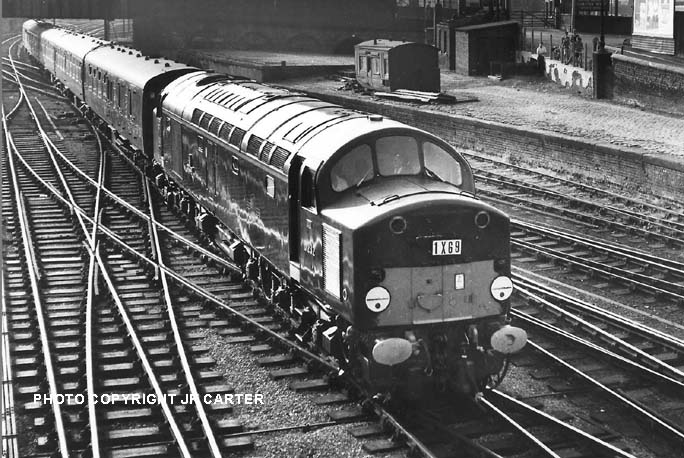
(Above-Below) No D233 was the first Type 4 allocated to Holyhead for crew training in November 1959, and by the Spring of the following year the EE Co machines became a regular sight on the North Wales Coast line, ousting in the process Holyhead's allocation of five 'Britannias' from 'Irish Mail' duties. On 30th June 1969, No D233 Empress of England was entrusted with Royal Train duties conveying guests to and from HRH Prince of Wales's investiture at Caernarfon Castle. The ensemble is seen passing Chester. (Below) For many years the Western Division of the LMR had to operate under the baleful influence of modernisation. The nature of engineering work required for WCML electrification included the lifting of road bridges, or lowering of track level to obtain the neccessary clearance for the overhead catenary. The WCML from Euston to Crewe required work on 78% of the 904 bridges concerned, whilst on the 44 mile between Crewe and Manchester, 82% of the bridges had to be rebuilt. Inevitably, the phase of modernisation involved prolonged disruption of train services. Here, EE Co Type 4 No D231- later to be named Sylvania - heads empty coaching stock of the 'Comet' express through Manchester Exchange for Ordsal Lane carriage sidings. The train had been diverted to Victoria due to modernisation of Manchester London Road.
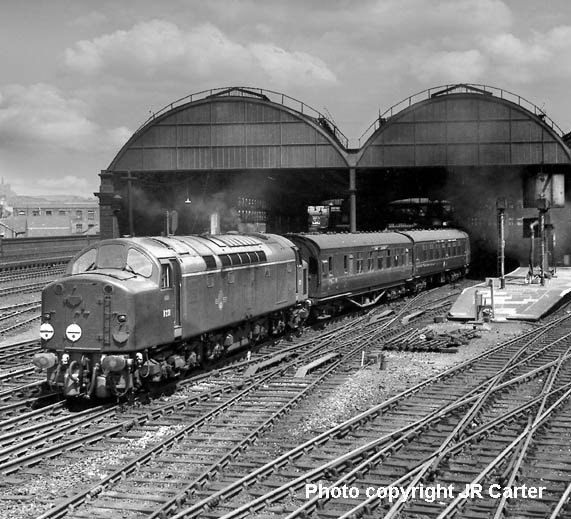
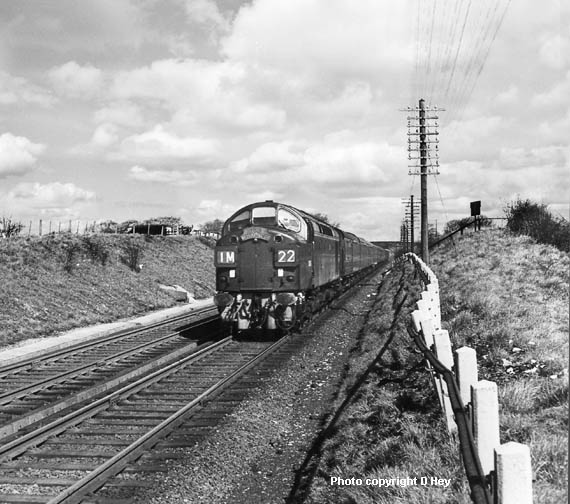
(Above) The LMR took delivery of its initial batch of EE Co's Type 4s Nos D210-D236 between May and November 1959. Nos D267-9/87-344 followed in 1960/61 - Nos D305-24 coming from the Robert Stephenson and Hawthorn works in Darlington. Finally, D369-84 arrived in 1961/62. The Type 4 fleet was soon employed on Anglo-Scottish trains, including the 'Royal Scot' often loaded to 14 bogies 510 tons gross. The split-type route indicator boxes of No D326 displays 1M22 southbound 'Royal Scot' as it heads south at Hest Bank on April 3rd 1961. CORRECTION - Martin Ramsdale informs me that the identity of this split box Class 40 is in fact D325 (not D326). Only D325 had the overhead live wire flashes displayed beneath the route indicator boxes as seen here..thanks Martin. Photo © D Hey
(Above-Below) Winwick Junction - a favourite location for 'Footplate Cameraman' Jim Carter. (Below) The Eastern Region was allocated the second batch of production Type 4s Nos D237-D259 between October 1959 and February 1960. The majority of the EE Co machines were fitted with a Stones-Vapor train heating boiler, except for Nos D260-D267 and D287-D304 which had Clayton types. An early investigation into electric train heating (ETH) led to newly-built No D255 (one of the ER's allocation) being handed over to the LMR at Derby where it was fitted with an auxiliary generator to supply electric train heating. No D255 was then transferred to Crewe for trials on the WCML to Carlisle. Although valuable experience was gained from the ETH experiment, the auxiliary generator was subsequently removed, and the fleet of EE Co Type 4s remained steam heat only throughout their careers Photos © JR Carter
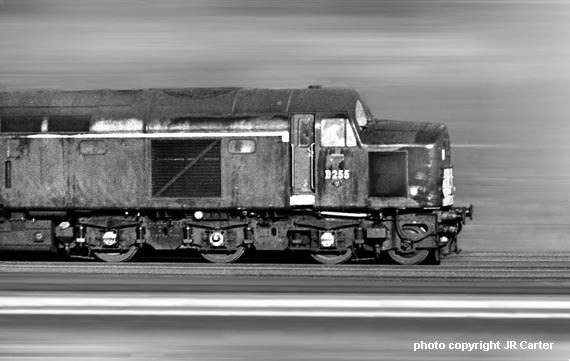
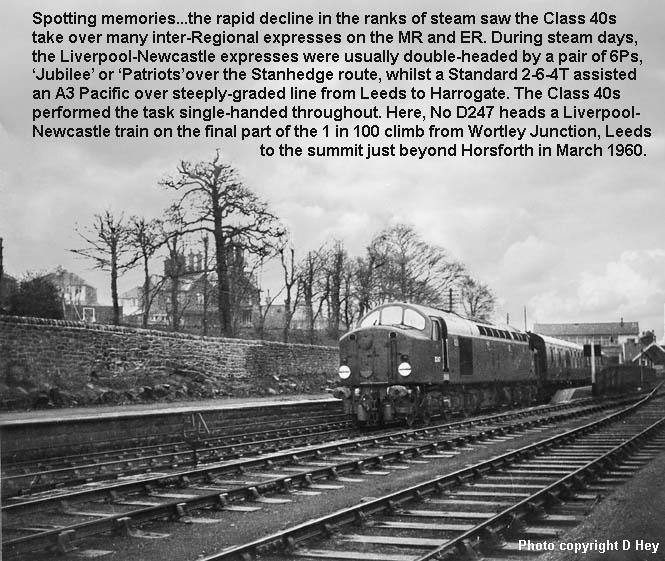
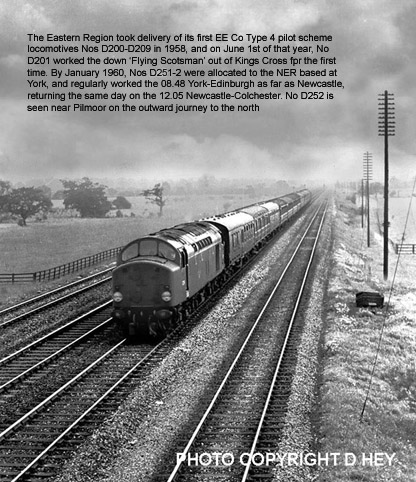
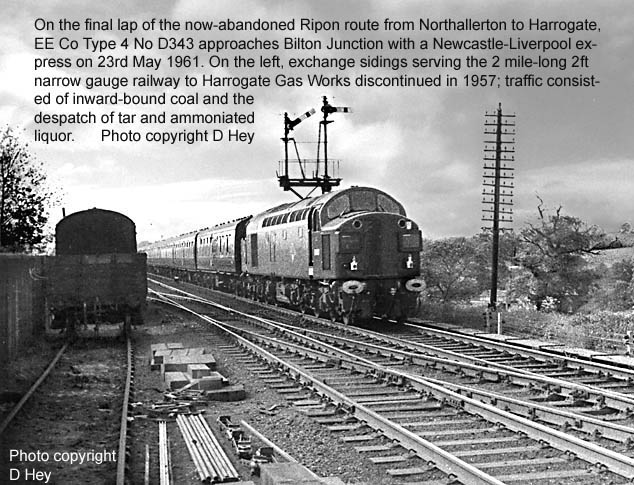




(Above) Super-wide image...click once, then again to see full size image. (Below) Photo-Link to the Class 40 Preservation Society's excellent website - Photo-link to the Class 40 page on the 'Extra' site.
BR/SULZER 'PEAK' TYPE 4 (CLASS 44-45-46)
Several other manufacturers were involved in the BTC orders, including the BR works at Derby which was responsible for building the last of the pilot scheme designs to enter traffic - the BR/Sulzer 2,300hp 1Co-Co1 Nos D1-D10 in 1959. The 10 Type 4 'Peak' locomotives were extremely heavy, turning the scale at more than 138 tons working weight which necessitated the use of the cumbersome 1Co-Co1 wheel arrangement in order to distribute the load. The Peaks had the dubious distinction of being the heaviest, yet they had a neat appearance - the nose-end closely resembling that of the LMS pioneers No 10000/1 into which gangway doors were provided. All ten locomotives (Class 44) were named after Welsh or English mountains, and the name 'Peaks' was subsequently dubbed on the production models, 127 of which were ordered before the first pilot scheme batch had actually been completed. Nos D1-D10 were allocated initially to Crewe.
(Above-Below) The ten pilot scheme BR/Sulzer 'Peaks' Nos D1-D10 (Class 44) were followed by 183 production locomotives Nos D11-D193, all built at Crewe and Derby to the same basic design, but equipped with the more powerful Sulzer 12LDA28 'B' engine uprated to 2,500hp. Later to become known as Class 45, Nos D11-D137 were fitted with Crompton Parkinson electrical equipment,and Nos D138-D193 (later Class 46) had Brush electrical equipment instead. Although the production Peaks were similar in appearance to the pilot scheme machines, some front end variations were incorporated when the gangway doors and white headcode discs were abandoned in favour of divided headcode boxes - one each side of the nose on Nos D11-31 and D68-107 - and a two-piece or solid route indicator panel centrally placed on the remaining locomotives. Sporting newly painted warning panels on the nose ends, No D3 Skiddaw strikes an impressive pose at Toton. (Below) Railway Cameraman, Jim Carter, photographed No D2 Helvellyn at Worsley, Manchester, with a diverted Glasgow-Euston express due to a derailment on the WCML south of Wigan.
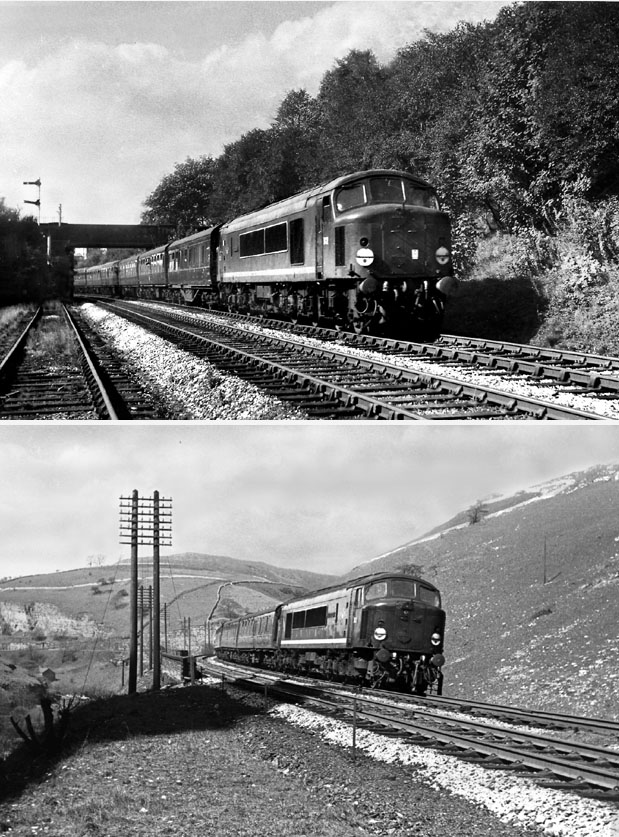
(Above-Below) ER Morten captures No D7 Inglebrough heading a Manchester Central-St Pancras express at Blackwell Mill. (Below) photo to be posted....

(Above) The headlong rush to eliminate steam in favour of modern diesel and electric traction led to several orders being placed with the manufacturers before the new designs had been fully evaluated in service conditions. For example, before the first 10 pilot scheme 2,300hp Type 4 diesels D1-D10 had been completed, the BTC placed orders for a further 183 members of the class. By chance, however, they proved to be one of the more successful locomotives to appear in the pilot scheme orders. The production 'Peaks' were uprated to 2,500hp by use of charge air cooling, which gave rise to three genetic types of basically similar locomotives - TOPS Class 44 (pilot scheme) and the Class 45 and 46 production locomotives. Crewe Works was responsible for building Nos D50-D137 in the fleet. The first build Crewe Peaks originally started at D68, but the order for D50-D67 was transferred from Derby to Crewe, then built after Crewe finished its D68-D137 order. The build numbers 262 & 282 on the cab windows indicate build No 26, 2 end (left) and build No 28, 2 end (right), hence the locomotive numbers are D93 & D95. In this Jim Carter shot outside the paintshop a newly-built D93 undergoes steam heat boiler tests. In the background is D90 fresh out of the paint shop and black smoke from a 'Scot' class 4-6-0 adds considerably to the picture. My thanks to Vic Smith of York for the additional information.
(Below) The 'Peak' class (later TOPS Class 45 & 46) proved to be one of the more successful locomotives to appear subsequent to the pilot scheme orders. Crewe Works was responsible for building Nos D50-D137 in the fleet (Class 45) and this view shows a newly-built No D105 standing alongside an ex-Crosti BR9 outside the Paintshop. Photo © JR Carter.
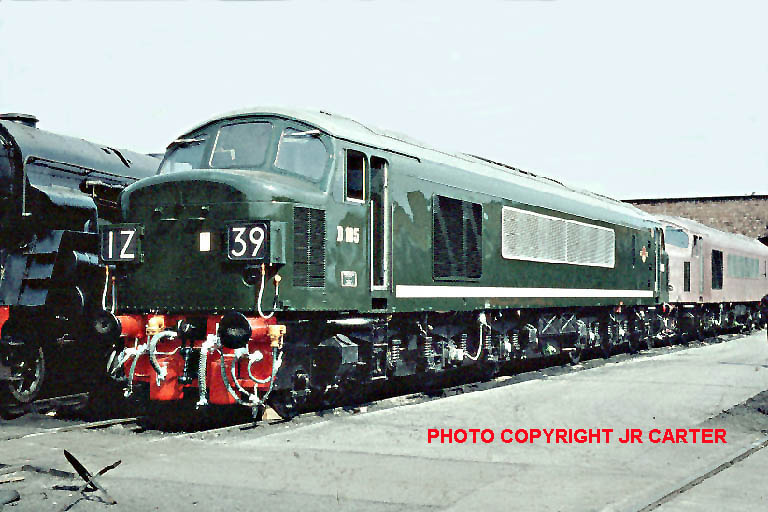
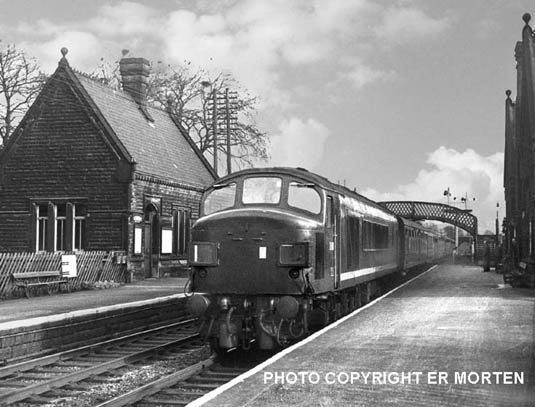
(Above-Below) In 1961, British Railways abandoned the aged 'disc' display system (a legacy of steam days) in favour of a new four-character letter and numeral headcode display. The train classification, destination and identification system was introduced to assist signalmen in identifying trains. The headcodes consisted of a four-character display; the first numeral identifying the class of train, followed by a letter indicating the destination, whilst the next two digits represented the train reporting number. For example, a headcode display starting with a '1' denoted an express passenger train and, until the system came fully into operation, locomotives were often seen with the first numeral showing only. (Above) In November 1959, 'Peak' class No D19 (later Class 45 No 45025) heads a 'down' train through Darley Dale - a name familiar to visitors to the preserved steam railway operated by Peak Rail. (Below) In the opposite direction, an unidentified 'Peak' displays the same configuration as it heads an 'up' train through Darley Dale. Over the years, vibrations caused the numbers to revolve on their own accord, and the varying non-descriptive digits that appeared in the panels was a major factor for BR's decision to dispense with headcodes entirely. From 1976, BR decreed that operating handles were to be removed and blinds set permanently at '0000', then during classified overhauls at Works the distinctive four-character headcode boxes were removed and two fixed-beam lamps were fitted on the nose. Both © ER Morten
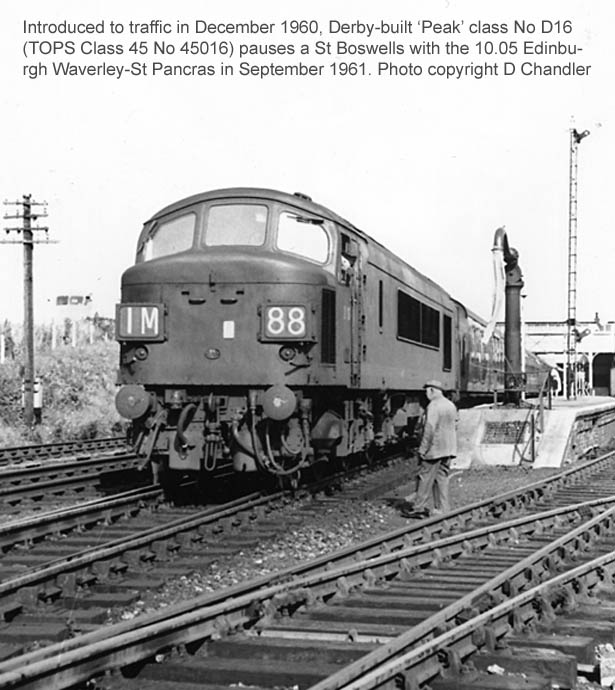
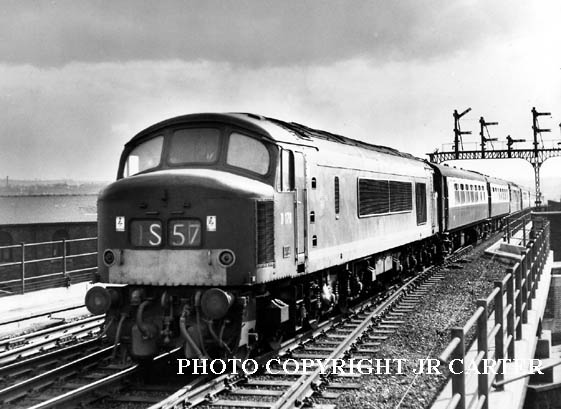
(Above) A famous headcode - 1S57 northbound 'Queen of Scots' - is displayed in the route indicator panel of Peak class No D170 (later TOPS Class 46 No 46033) as it approaches Wortley South Junction. The train is made up of an almost uniform rake of the new Metro-Cammel Pullman cars, first introduced on the London-Sheffield 'Master Cutler' Pullman in September 1960. They appeared on the'Yorkshire Pullman' and 'Tees-Tyne' Pullman duties in January the following year. The 44 vehicles were used entirely on the East Coast main line services, but as no Pullman brake cars were built in the same order, the elderly flat-sided Pullman brakes were utilised, in this case situated the third vehicle from the front. With the introduction of more modern coaching stock fitted with electric train heating (ETH) - the original train heating boilers and water filling point were removed from cantrail height to prevent crewmen climbing up to roof level in areas with overhead electrification equipment. The 3 bodyside steps were subsequently plated over.
(Below) When Gateshead shed (52A) became the principal diesel depot on Tyneside, the remaining steam workings were confined to Heaton, although England's last A4 No 60001 Sir Ronald Mathews remained at Gateshead up to its withdrawal in October 1964, together with eight Class A3s and a few V2s held as reserves in case of diesel failures. Gateshead's two roundhouse turntables were removed to make way for a straight diesel shed and a diesel maintenance depot extension. Having taken delivery of its first 'Peak' class during the first week of May 1962, the shed was quick to put its allocation Nos D166-D193 (later TOPS Class 46 Nos 46029-56) into service. By June 1962, they were working 'Tees-Tyne Pullman', 'Yorkshire Pullman' and Kings Cross-Newcastle expresses, sharing the company of the Deltics. Although the Peaks were less revered than the Deltics, they were very much in front line duty, particularly on the Trans-Pennine route and Northeast-Southwest services. The split headcode boxes of No D93 (later Class 45 No 45057) show 1V47 16.05 Newcastle-Bristol, as it passes Deerness Valley Junction on July 24th 1963. The train had been diverted via Bishop Auckland due to blockage of the ECML at Ferryhill.
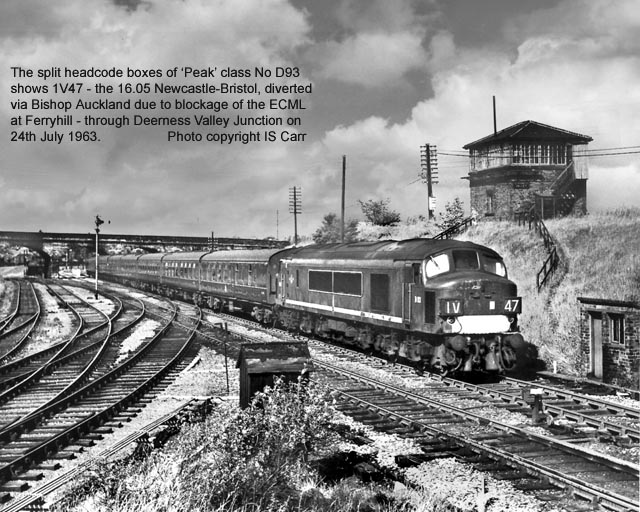
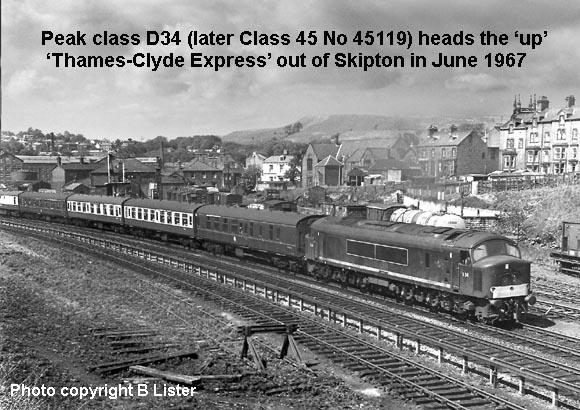

(Above-Below) 'Peak' class No D41 (later Class 45/1 45147) heads a northbound express past Kirby Stephen West box on 6 August 1966. The locomotive is sporting the compulsory rectangular yellow warning panel on the nose-end, although its effectiveness is somewhat spoiled by the centre position of the four-character headcode panel which restricts its size to the lower half of the nose. (Below) The rectangular yellow warning panel was standard through the 'Peak' series except for No D148 (later Class 46 46011) which was given a larger panel. No D148 heads a southbound express at Engine Shed Junction, Holbeck on 7 July 1963. In the background, Holbeck shed yard houses a fair complement of steam together with a pair of Class 25s and a solitary Class 03 shunter with its distinctive 'wasp' striped cab. The shed closed to steam on 30th September 1967, and three years later the roundhouse buildings and No 1 type coaling tower were demolished.
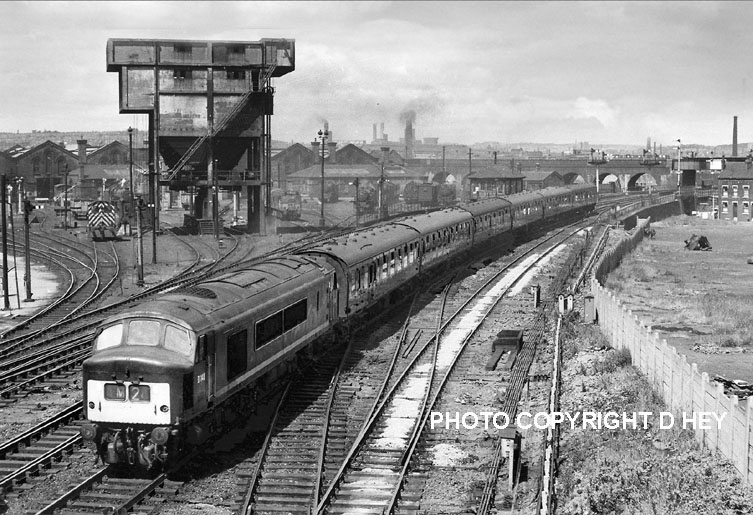
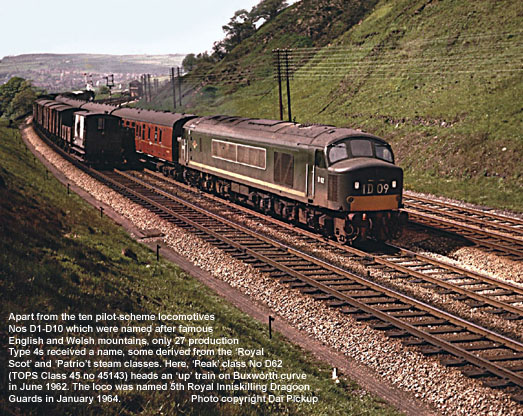
(Below) The five 2,000hp A1A-A1A diesel-hydraulic locomotives Nos D600-D604 destined for the Western Region, were constructed by the North British Locomotive (NBL) works at Glasgow. The locomotives were given names of famous warships in alphabetical order: Active, Ark Royal, Bulldog, Conquest and Cossack. No D600 Active commenced revenue-earning service on 21st April 1958 working two return trips daily between Plymouth and Penzance. By 1961, the new D800-series 'Warship' locos became available to the operating department, and the D600s were displaced from principal duties on the West of England main line and assigned to less demanding duties working Cornish china clay traffic. By 1966 poor availability and high running costs prevented further use of this non-standard class and Nos D600-1 were sold to Dai Woodhams of Barry whilst D602, D603-4 met their fate at Cashmore's of Newport. Sporting the standard BR green livery with a blue/grey stripe running the length of the bodyside between the cabs, No D604 Cossack rests between duties at its home shed of Plymouth Laira.
Further photos of the WR's diesel-hydraulic classes can be found by clicking on this photo-link below which will take you to Page 22. You will find 'Dieselisation BR Western Region' at the foot of the page.
Polite notice: All text and photographs are protected by copyright and reproduction is prohibited without the prior consent of the © owners. If you wish to discuss using the contents of this page the email address is below. Please note - this is not a 'clickable mail-to link via Outlook Express:
dheycollection@ntlworld.com

